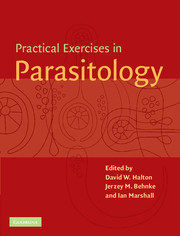Book contents
- Frontmatter
- Contents
- List of contributors
- Preface
- General advice
- 1 Observational Exercises on Parasites
- 2 Ecology
- 3 Physiology and Biochemistry
- 3.1 Hatching in vitro of oncospheres/hexacanth larvae of Hymenolepis diminuta
- 3.2 Activation of the cysticercoids of Hymenolepis species in vitro
- 3.3 Membrane transport in the cestode Hymenolepis diminuta, in vitro
- 3.4 Glycogen utilisation and deposition in flatworm parasites
- 3.5 Effects of classical transmitters on the motility of parasitic roundworms and flatworms
- 3.6 Electrophysiology of Ascaris suum body muscle
- 3.7 Immunocytochemical localisation of neuroactive substances in helminth parasites
- 4 Pathology and Immunology
- 5 Chemotherapy
- 6 Molecular Parasitology
- 7 Behaviour
- Appendix 1 Reagent index
- Appendix 2 UK suppliers
- Appendix 3 US suppliers
- Index
3.6 - Electrophysiology of Ascaris suum body muscle
Published online by Cambridge University Press: 05 June 2012
- Frontmatter
- Contents
- List of contributors
- Preface
- General advice
- 1 Observational Exercises on Parasites
- 2 Ecology
- 3 Physiology and Biochemistry
- 3.1 Hatching in vitro of oncospheres/hexacanth larvae of Hymenolepis diminuta
- 3.2 Activation of the cysticercoids of Hymenolepis species in vitro
- 3.3 Membrane transport in the cestode Hymenolepis diminuta, in vitro
- 3.4 Glycogen utilisation and deposition in flatworm parasites
- 3.5 Effects of classical transmitters on the motility of parasitic roundworms and flatworms
- 3.6 Electrophysiology of Ascaris suum body muscle
- 3.7 Immunocytochemical localisation of neuroactive substances in helminth parasites
- 4 Pathology and Immunology
- 5 Chemotherapy
- 6 Molecular Parasitology
- 7 Behaviour
- Appendix 1 Reagent index
- Appendix 2 UK suppliers
- Appendix 3 US suppliers
- Index
Summary
Aims and objectives
This exercise is designed to demonstrate:
Some electrophysiological properties of nematode muscle cells.
Measurement of intracellular membrane potentials from A. suum muscle by recording from the bag (muscle cell body) region.
Recording the electrophysiological effects of piperazine, an inhibitory γ-aminobutyric acid (GABA)ergic anthelmintic.
Recording the electrophysiological effects of pyrantel, an excitatory nicotinic anthelmintic.
Introduction
Adult Ascaris suum are large parasitic nematodes that may be recovered from the intestine of pigs slaughtered at the abattoir. Mature female A. suum may be up to 35 cm in length. The number found in each pig varies dramatically from area to area and relates to the husbandry/hygiene on which the pig has been raised. Migrating A. suum larvae may cause significant scarring of the liver (milk spot) as they pass through this organ before entering the lungs and reaching the upper intestine where adults are found. After mating, many thousands of Ascaris eggs are produced each day by the mature female and are released in faeces.
Human infection with A. suum is rare. The species of Ascaris that regularly infects humans is Ascaris lumbricoides. Over half the world's human population is infected at one time during their lives with A. lumbricoides. Treatment of these infections in man or animals involves the use of anthelmintics (i.e.antihelminth drugs), which have a selective action on the nematode parasite without affecting the host.
- Type
- Chapter
- Information
- Practical Exercises in Parasitology , pp. 219 - 230Publisher: Cambridge University PressPrint publication year: 2001



